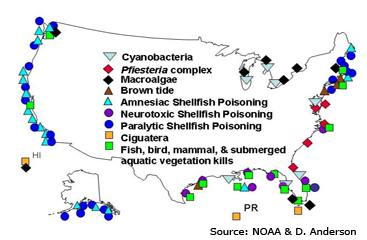You are here: Home › Stressors › Extreme Natural Events › Harmful Algal Blooms › Current Programs › Ecology and Oceanography of Harmful Algae Blooms (ECOHAB)
Ecology and Oceanography of Harmful Algal Blooms (ECOHAB)
Click here for a listing of ECOHAB research abstracts
Issue

Harmful algal blooms (HABs) are one of the most scientifically complex and economically significant coastal issues facing the nation today. HABs have direct and indirect impacts on fisheries resources, local coastal economies, as well as public health and perception. HAB toxins can cause human illness and death, halt the harvesting and sale of fish and shellfish, alter marine habitats, and adversely impact fish, endangered species, and other marine organisms. In the past, only a few regions of the U.S. were affected by HABs, but now virtually every coastal state has reported major blooms. Economic losses associated with HABs are conservatively estimated to exceed $1 Billion over the next several decades. High biomass blooms can also profoundly affect marine and freshwater ecosystems. There are many gaps in current knowledge that need to be addressed. Development of methods for rapid, cost effective detection of HABs and their toxins is a critical first step. Predictive models and forecasts depend on an understanding of the basic biology of HAB species, the environmental processes that control HABs, and knowledge of how HAB toxins are transferred through the food web and impact the health of a variety of organisms, including humans. The role of human activities in stimulating HABs requires investigation. Effective methods for prevention, control, and mitigation need to be developed.
Approach
ECOHAB is a multi-agency partnership between NOAA' s Center for Sponsored Coastal Ocean Research (CSCOR) and the National Science Foundation, U.S. Environmental Protection Agency, National Aeronautics and Space Administration, and the Office of Naval Research. Through a combination of long-term regional studies and short-term targeted studies, ECOHAB seeks to produce new, state-of-the-art detection methodologies for HABs and their toxins, to understand the causes and dynamics of HABs, to develop forecasts of HAB growth, transport, and toxicity, and to predict and ameliorate impacts on higher trophic levels and humans. Research results will be used to guide management of coastal resources to reduce HAB development, impacts, and future threats. Projects selected for support must successfully compete in a rigorous external, peer-review process that ensures a high-level of scientific merit. Projects include a mix of investigators from academic, state, Federal (including NOAA Ocean Service), and non-profit institutions.
Accomplishments
ECOHAB has funded regional projects in the Gulf of Maine (Alexandrium), eastern Gulf of Mexico (Karenia brevis, known as the Florida Red Tide), mid-Atlantic (Pfiesteria), Pacific Northwest (Pseudo-nitzschia), shallow bays and lagoons of eastern Long Island (Aureococcus anophagefferens, known as the Long Island Brown Tide), and Maui, Hawaii (macroalgae). These projects have greatly increased our understanding of HAB dynamics and are leading, in some cases, to the development of biophysical models that show excellent promise for forecasting HAB impacts. The targeted projects have developed new detection methodologies that are already being used in state monitoring programs, increased our understanding of the role of human activities in stimulating HABS, determined the trophic transfer of toxins through the food web, found natural and developed new control mechanisms that may be useful in mitigation and control, investigated the causes, and impacts of newly emerging HAB problems, and summarized the economic impacts of HABs. ECOHAB projects are often closely linked to Monitoring and Event Response for Harmful Algal Bloom (MERHAB) projects in order to facilitate transfer of new knowledge and techniques to existing coastal monitoring programs while building sustainable regional partnerships.
Related Links
The Ecology and Oceanography of Harmful Algal Blooms: A National Research Agenda
For more information, contact:
NOAA/NOS/NCCOS/CSCOR
Quay Dortch
phone: 301-713-3338 ext. 157
e-mail: coastalocean@noaa.gov

